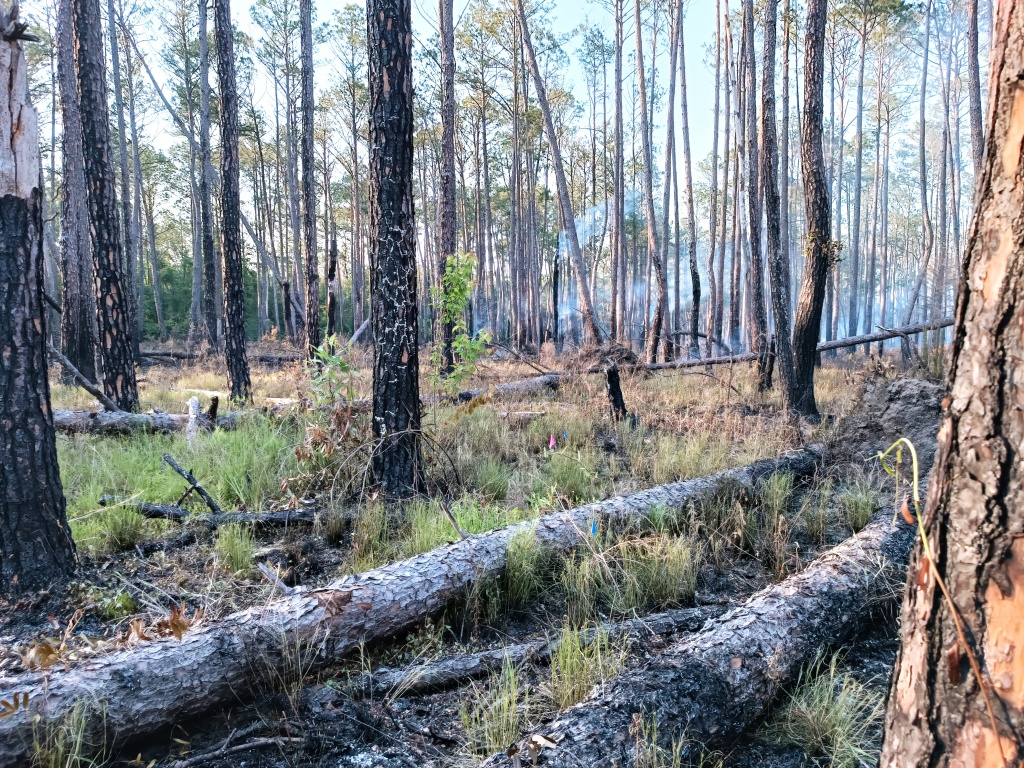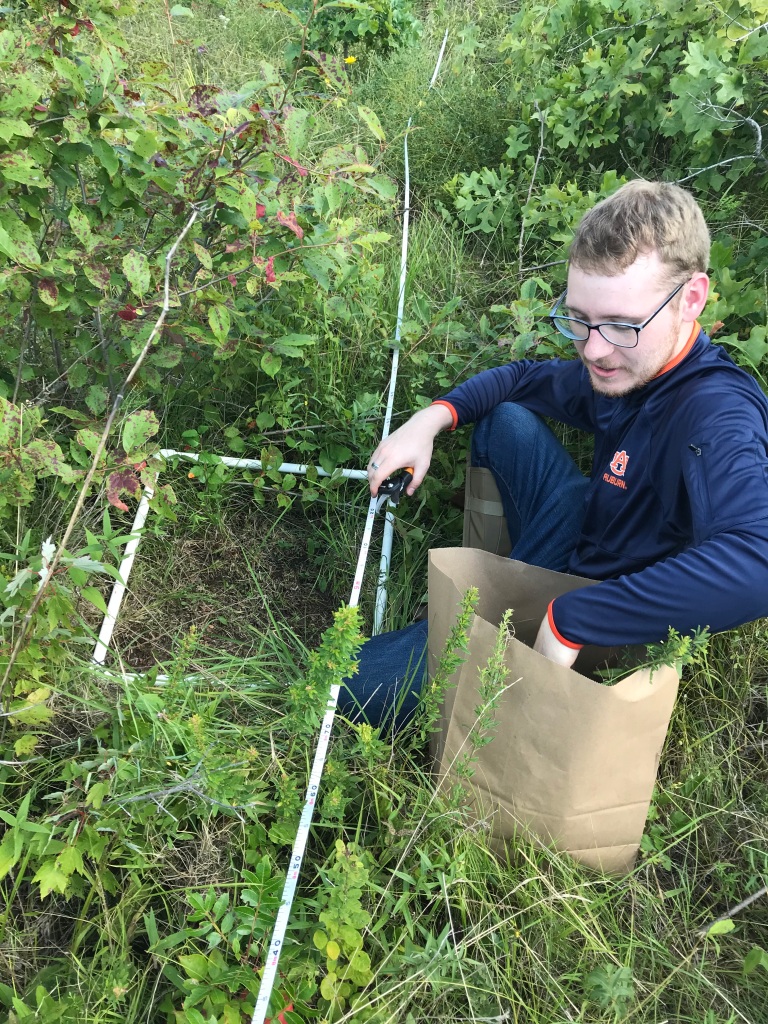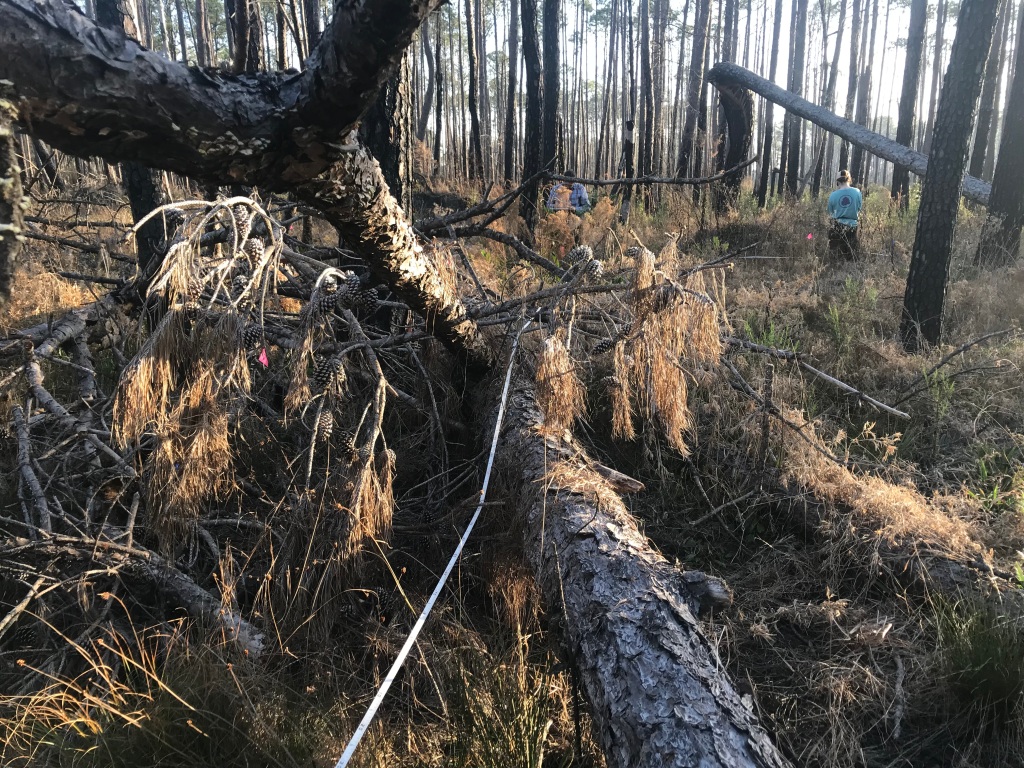Auburn researcher studies connection between forest fires, greenhouse gasses
by Sydney Cromwell
If a tree falls in the forest and there’s nobody around to measure it, how do we know how much carbon is stored inside it?
If that information doesn’t seem useful to you, consider that the next time a fire travels through the forest, that fallen tree will burn and release its carbon back into the atmosphere, contributing to overall greenhouse gas emissions.
At Auburn University’s Forest Fire and Ecology Lab, researcher Heather Alexander is studying the balance between the carbon stored within plants and the carbon released during a wildfire or controlled burn — and how destructive events like hurricanes and tornadoes can tip that balance.
BURN, BABY, BURN
The use of controlled or prescribed fires in the U.S. dates back to original native societies, long before there were even 13 colonies.
However, beginning in the early 1900s, many people viewed fire solely as a destructive force, and it became standard practice to suppress and prevent fire as much as possible. To keep forests healthy, the thinking went, you had to keep fire out.
But instead, the lack of fire allowed forests to get denser, crowding out certain fire-dependent plant species and creating a layer of fallen tree limbs and other dead plant matter — perfect tinder, just waiting for a spark to blossom into a massive wildfire.
Regular, low-intensity fires help create space for new growth, improve the soil and clear out dead wood so it doesn’t build up.
“We as humans have completely altered the natural fire regime in this country and across the planet,” Alexander said. “… We’ve left fire out of the system for so long that we’ve created, essentially, a system where the fires become catastrophic.”
Attitudes toward controlled burns began to change in the 1960s and 1970s. Nowadays, it’s more common to see controlled burning as part of forest management, though not everywhere.
“I think we have convinced, to some degree, landowners, land managers and politicians that prescribed fire is critical,” Alexander said.
“These fires are burning so much more intensely, and so much more frequently, and in so much more area than we’re used to, that they’re burning carbon that shouldn’t be burned.”
Heather Alexander, Auburn Forest Fire and Ecology Lab
The Southeast has been on the forefront of using prescribed fire for a long time, particularly among private landowners. One study estimated that 70% of controlled burns in the U.S. between 1998 and 2018 happened in the Southeast.
Mountain Longleaf National Wildlife Refuge, near Anniston, is one such forest where Alexander has recently worked on reintroducing low-intensity fires.
Another is the Oakmulgee Ranger District of Talladega National Forest, where the Forest Service does controlled burns to restore longleaf pine savannas and preserve habitat for red cockaded woodpeckers, turkeys and deer, assistant fire management officer Trevor Callaghan said.
The Forest Service began using controlled burns in Oakmulgee in the 1960s, Callaghan said, but only around 600 to 1,200 acres per year. Its use has ramped up since the 1980s, and now they burn 30,000 to 50,000 acres in the district each year, he said.
“If we want those forests to keep going, then we need to be able to burn them,” Alexander said.
Read more from Southern Science about how fire is used to restore grasslands and longleaf pine forests in Alabama.
Across biomes and continents, Alexander has seen the restorative power of managed fires, from Alabama’s longleaf pines and Kentucky’s upland oaks all the way to the northern forests of Alaska and Siberia, where she spent several summers researching between 2010 and 2019.
She has been an associate professor at Auburn’s Forest Fire and Ecology Lab for three years.
“I’ve been working on fire, thinking about fire, for a really, really long time,” Alexander said.
FUEL FOR THE FIRE
A healthy forest tends to be a carbon “sink” — that is, the plants take in carbon dioxide from the air to fuel their own growth. Some of that carbon returns to the atmosphere when plants die and decompose, but that amount is usually less than what the plants originally removed.
Fire is “basically like decomposition sped up really fast,” releasing more carbon more quickly, Alexander said.
With regular, low-intensity fires, she said, a forest can typically rebuild its lost plant life before the next fire and its carbon storage isn’t harmed. But when a wildfire is consuming several years’ worth of dead and living plant matter at once, all of a sudden the balance shifts and the carbon being released into the air outweighs what the forest is able to take in for years or even decades.
“These fires are burning so much more intensely, and so much more frequently, and in so much more area than we’re used to, that they’re burning carbon that shouldn’t be burned,” Alexander said.

It doesn’t always take years to build up that kind of fuel source. After a strong wind storm, tornado or hurricane, Alexander said, suddenly there’s a whole lot of newly dead wood on the ground from fallen limbs and downed trees.
Alexander said her current research came about because she wondered how those windfalls affected the forests’ carbon cycle and whether forest managers need to change the way they handle controlled burning after severe weather.
“What is that dead wood doing in these systems? Is it creating highly flammable forests that’s going to lose a lot of dead wood the next time it burns?” she said.
MEASURING A FOREST OF CARBON
To find out, Alexander has to track the kinds of plant matter and the amount of carbon being stored in a particular forest for several years, so she can see how it changes after a fire or severe storm and how long it takes the forest to recover.
Since 2022, Alexander and the Auburn lab team have been conducting their research at several coastal sites to measure wind and hurricane impact, including Weeks Bay Reserve in Baldwin County and the Perdido River Preserve in Florida, along with sites in central Alabama to monitor potential tornado damage, such as the Oakmulgee Ranger District.
Measuring an entire forest’s worth of plant life simply isn’t feasible, so other techniques are required. Some researchers have used satellite images or laser sensors, but Alexander’s approach is more hands-on.
The lab’s researchers set up a fixed plot at each research site and then measure the trees, both dead and alive, within that site. They use equations to estimate the trees’ mass and carbon storage capacity, so they don’t have to be cut down.
“That’s actually kind of the easy part,” Alexander said.
Next, they clip, dry and weigh the shrubs, grasses and other smaller plants within that plot to find out their biomass. Then, they do the same thing with leaf litter and other decomposing material on the forest floor. Finally, they take soil samples to weigh and analyze for carbon content.

With all those measurements, Alexander then has a pretty good estimate of the amount of carbon stored within that plot of land, which she can then use to approximate the entire forest.
Do the same series of measurements after a fire, and you can get a sense of what’s changing.
A year after wind damage and a controlled burn, the coastal sites Alexander has been studying have regained about three-quarters of the carbon they lost during the burn, she said.
On the other hand, one of her research sites had a lightning strike that caused a wildfire, which Alexander said released four times as much carbon as the prescribed burn and will take longer for the plant life to bounce back.
Alexander said she wants to continue measuring at these sites for five or 10 years, to see how multiple seasons of controlled burning and severe weather affect the carbon balance.
A SHORTENED SEASON
There are already certain weather conditions needed to keep a safe controlled burn from becoming an unmanageable wildfire.
In the Oakmulgee Ranger District, Callaghan said drought conditions have made it hard to burn enough acreage in the fall, and the difference in the forest is noticeable.
“It’s been kind of rough to get that number the last few years, just due to the drought conditions,” he said. “… It definitely takes a toll on things because we don’t get much of the underbrush killed during the growing season.”
Plus, there has to be consideration for the other species living in the forest. The discovery of endangered tricolored bats at Oakmulgee means that the Forest Service now must change many of its management strategies, Callaghan said, including limits on burning between early April and October, when the bats are nesting.
“That’s going to kind of shorten our burn season,” he said. “… A lot of the burns that we would do in April, now we’re going to have to force into February or March.”
Severe weather windfalls may become another important factor, requiring forest managers to further change the timing of their burns or practices like salvage logging to remove dead wood.

In his four years at Oakmulgee, Callaghan said eight tornadoes and one hurricane have hit the ranger district. The district will sometimes sell salvaged timber after those storms to clear up the deadfall left behind.
In areas where nobody wants the salvaged timber, however, he said the forest gets so dense that it will take three or four burns to clean up, and sometimes the fires have to be lit by aircraft rather than from the ground.
Since controlled burns have to be spaced out over time, Callaghan said, in those dense forests “we’re looking at a six- or eight-year process of getting it back to where it should be.”
THE FOREST’S FUTURE
Once she has collected years’ worth of data from these research sites, Alexander said she hopes the results can be used by people who upkeep and manage forests to make carbon-friendly decisions about when and how to burn.
“It’s very difficult to manage a Southeastern forest without fire,” she said.
“If we want those forests to keep going, then we need to be able to burn them.”
Heather Alexander, Auburn Forest Fire and Ecology Lab
Callaghan said that, in his experience, carbon sequestration isn’t often part of the conversation when it comes to forest management in the South, though it’s more common in Western states.
“There’s just more people researching it and more people concerned about what’s happening” in places like California, he said.
Changes in policy tend to be “very slow,” he said, and the impact of Alexander’s research could take a decade to appear.
“It’s not going to be an overnight thing,” Callaghan said.
Alexander said she hopes that “people don’t fear fire because of this carbon,” since healthy forests with well-controlled fires have a net-positive impact on the world’s greenhouse gas levels.
“Forests are incredibly capable of taking carbon out of the atmosphere and putting it into their own biomass, and we need them to be productive,” she said.
Main article image of a controlled burn in a longleaf pine forest, courtesy of the U.S. Forest Service.

